Larami’s Museum set is looking pretty dated now, but it’s a charming playset all the same and one of the more memorable imitators out there.
It’s said that imitation is the sincerest form of flattery; by that metric the dinosaur toy industry has been incredibly generous towards the leading toy brands. Anyone interested in vintage dinosaur lines, in particular, is probably aware of the sheer volume of recasts and knockoffs produced of models originally released by Marx, Tim Mee, and Ajax, among others. One of the many companies participating in the imitation game was Larami Corporation, which was originally founded in 1959. Although the company’s biggest claim to fame was likely the formulation of the Super Soaker water gun line in the 1980s, Larami had a long history of producing a variety of dollar store and “rack toy” merchandise sold in grocery and pharmacy stores, often featuring licensed IPs such as Marvel heroes and Battlestar Galactica, among many others. Larami also released several dinosaur toy sets based on the designs of older, more famous toy brands, like the aforementioned Marx and Tim Mee Toys. In 1987, Larami attempted to elevate their dinosaur releases with three boxed sets featuring larger, brand-new dinosaur molds.
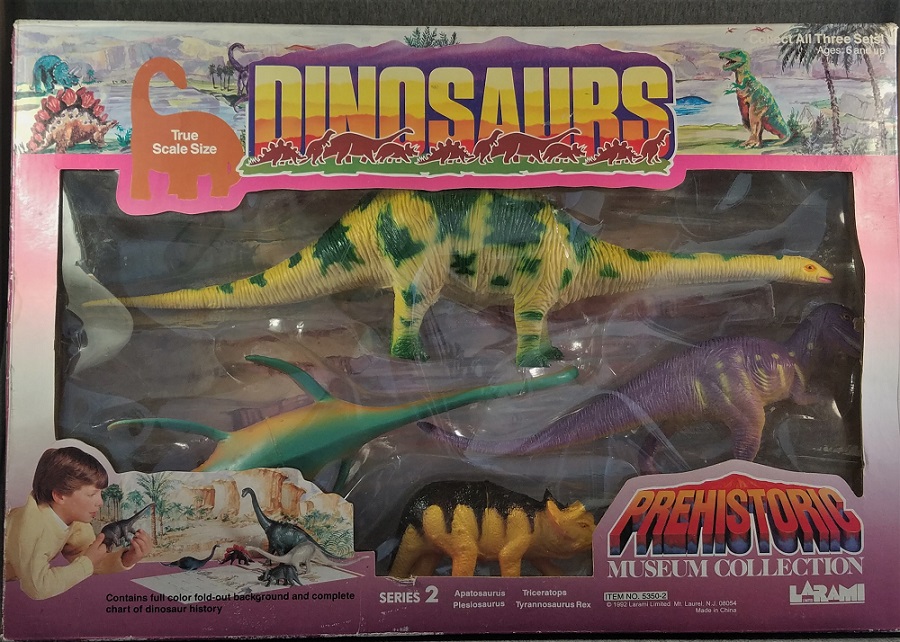
…Except, “brand-new” isn’t entirely true: over half of Larami’s new, larger figures were clearly modeled after those of the contemporary brand Invicta, whose sturdy, monochrome line of figures for the British Museum of Natural History were destined to pave the way for grander and even higher-grade museum lines, such as Safari ltd’s Carnegie Collection and Battat’s Boston Museum series. Larami’s output – itself branded as the “Prehistoric Museum Collection” – is somewhat quaint in comparison. To Larami’s credit, though, this was still a major step up from their prior dinosaur products. Perhaps someone in the executive chair saw the tides turning to a new age of dinosaur toys? …Probably not; but those Invicta models were clearly selling well enough to get somebody craving a piece of the pie.
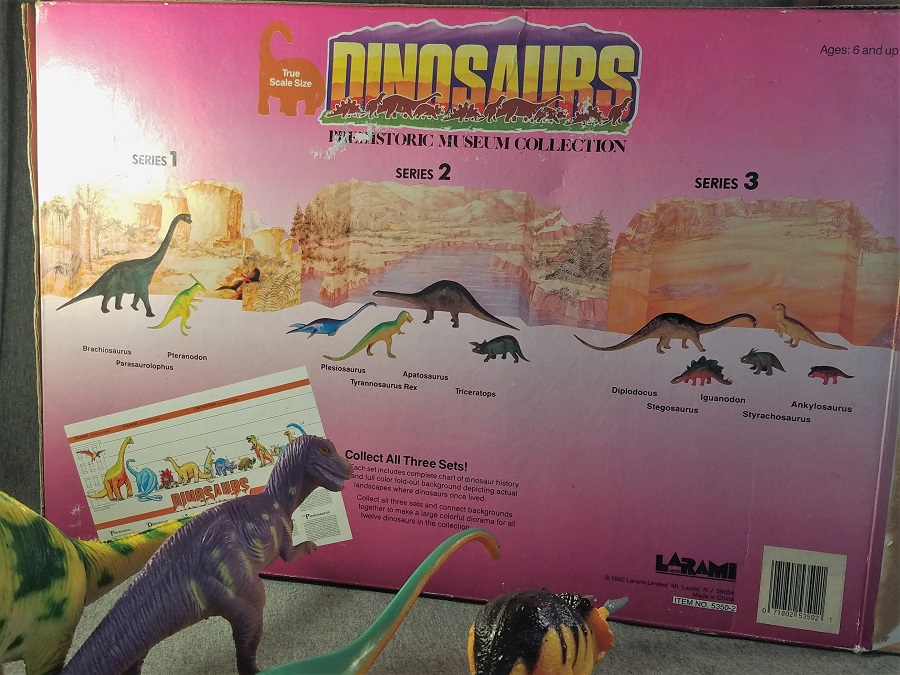
Following the initial releases in the late 80s, Larami Corp reissued their Museum sets in the 1990s with some revisions. For this review I’m covering Series 2 of the reissued sets (copyrighted 1992 on the box), which I recently acquired thanks to a moment of good time and chance while browsing on eBay. Complete boxed sets are pretty rare anymore; this particular set was yet unopened, but weathered enough that some thorough cleaning and even disassembly of the box was necessary before properly appreciating the items within (oh well, I wasn’t worried about mint condition anyway). The box measures 46 cm (18 in) long and 31.5 cm (12.5 in) tall; it can be opened on either end, although it’s not designed with any re-sealable parts. The back of the box displays all three box sets and their contents, encouraging buyers to “collect all three sets!” The selected photo art featured on the box depicts the 1st-release versions of dinosaur toys, which were generally darker and drabber in coloration.
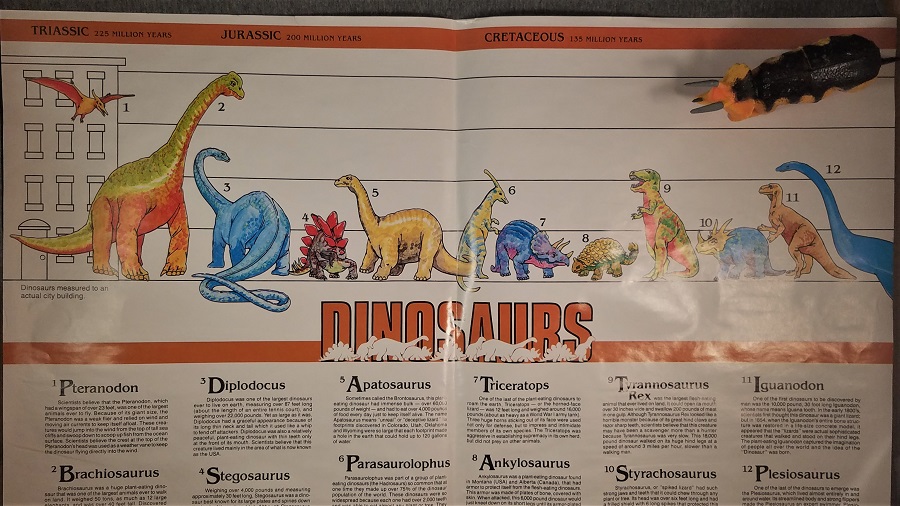
Inside the box, in addition to the main dinosaur models, a large glossy poster featuring all of Larami’s choice prehistoric genera in (crude) scale with each other, with additional information for each creature below (I haven’t done a thorough proof-read of the whole poster, but it looks like there might be some… interesting trivia included). Of greater note is a three-fold cardboard backdrop painted with attractive watercolor-style pastels, featuring a river surrounded by mountains. Each set appeared to feature a unique backdrop (based on the back of the box), which is a nice touch and probably the most appealing asset of the set, besides the figures themselves.
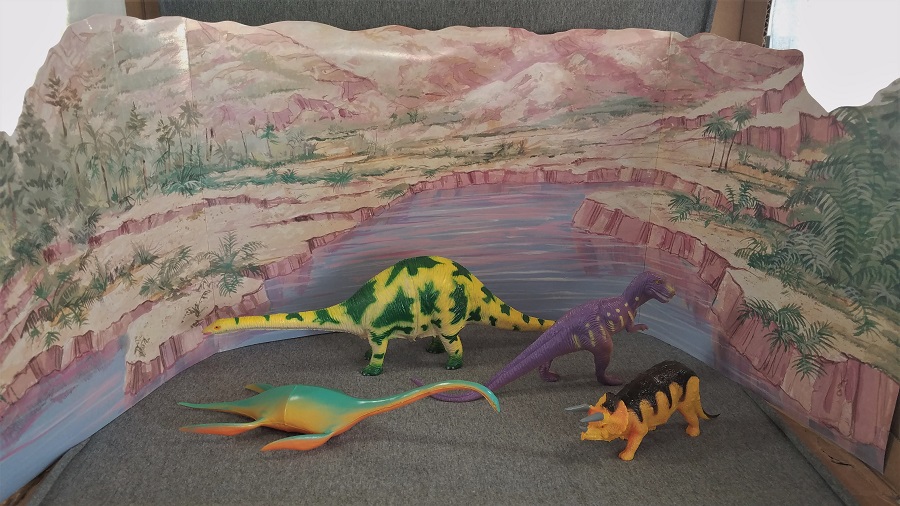
Four Models are included in the Series 2 set. The biggest figure – and the one truly unique sculpt in the set – is Apatosaurus, measuring 41 cm (16 in) straight from head to tail. One could compare the figure’s rigid-looking posture to that of the Invicta Cetiosaurus, but it is indeed an original sculpt. The figure is made of soft hollow plastic, squishy like a bath toy with tiny air holes between the body seams. Although imagery on the box advertises a rather dull, dark brown paint job seen in the figure’s 1st release, this reissued version from the 90s is a much more lively yellow hue with large green splotchy patterns across the body, almost looking like a creature that should in a vibrant modern-day coral reef instead of above-ground forests. It’s an extravagant choice, but it certainly catches one’s attention. The eyes and mouth on the otherwise detail-less face are highlighted orange and pink, respectively.
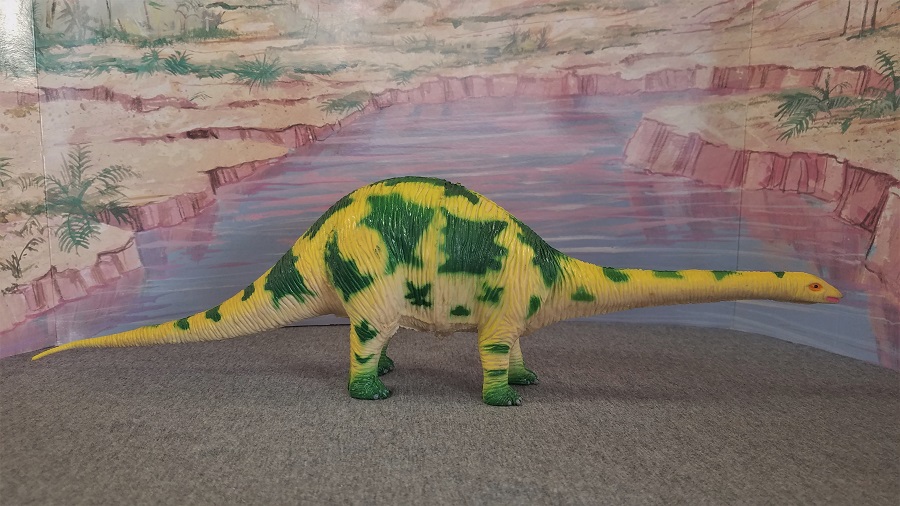

Apatosaurus may not be imitating another brand’s design, but that’s not much to its credit in this case; the figure is charming mostly in how dopey-looking it is. The head, while not shaped like a Camarasaurus skull at least, is plain and expressionless like some generic, poorly-researched depiction of a lizard or snake, rather than anything resembling a true Apatosaurus skull. The torso is sloped and rotund with large seam lines running along the spine, midsection, and underbelly; and the limbs are fairly short and stumpy in a basic manner akin to early 20th century reconstructions of the animal (which were in the process of being drastically revised when Larami was making these toys). Texturing on the model is dramatically pronounced, with craggy wrinkles all over the body that would make an elephant look soft-skinned. The softness of the plastic and the flexibility of the extremities make this toy fun to handle, admittedly; but on all accounts this model was designed on stereotypes of sauropod imagery rather than any proper reference or research. Not very “Museum Collection” after all.
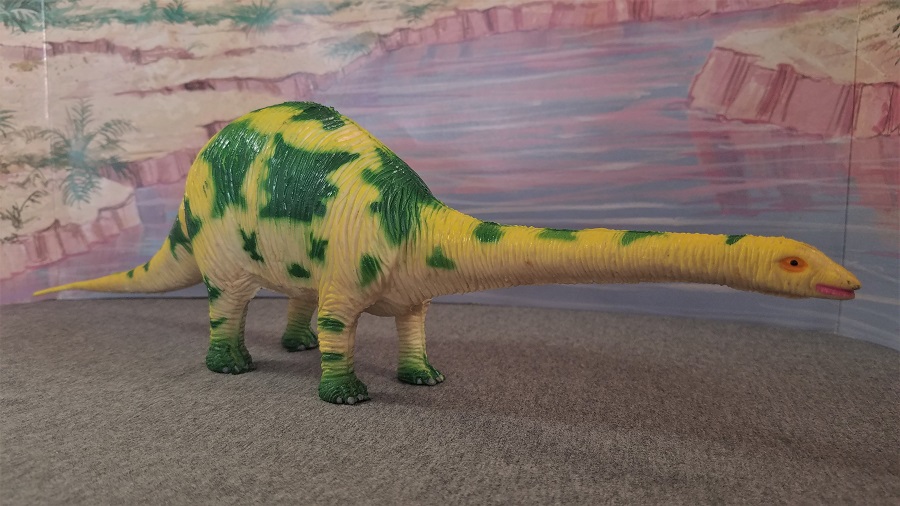
The rest of the figures in the Series 2 set generally fare better in appearance; the nicest of the lot is almost certainly the Plesiosaurus, which is modeled closely after Invicta’s version (for better or worse). Like the Apatosaurus, Larami’s Plesiosaur is squishy-soft and hollow, with tiny air holes poked into the mid-section body seam; these seams are still obvious on the figure, certainly much more than any mold marks on Invicta’s counterpart. Unlike the over-textured Apatosaurus, however, the sleek, minimalistic sculpt of the Plesiosaurus retains the completely smooth skin texture (besides seam lines) seen originally in the Invicta model; indeed, at 27 cm (10.75 in), the Larami figure is nearly identical in size and proportions to Invicta’s. While the posture is simple, the Plesiosaur largely maintains a gracefulness in appearance, depicting an animal relaxed in motion, its head gently raised like a waterfowl floating on the waterways. This range of flexibility and neck strength is considered far less feasible now than it once was; but arguably Larami’s (and Invicta’s) take on the classic image is more conservative and perhaps less far-fetched than the elaborate swan S-curve often seen in artwork. The flippers are the biggest change in Larami’s take, having been rotated around the shoulder region at an upward angle, exposing the undersides of the flippers more. The slope of the neck and the definition to the skull are also simplified somewhat, but still closely follow the form of the Invicta design. As an interesting aside, while both the box and the included poster label the figure as Plesiosaurus proper, the actual toy follows Invicta’s example and is labeled more ambiguously as ”Plesiosaur”, so the true identity of this genus may be up for interpretation.
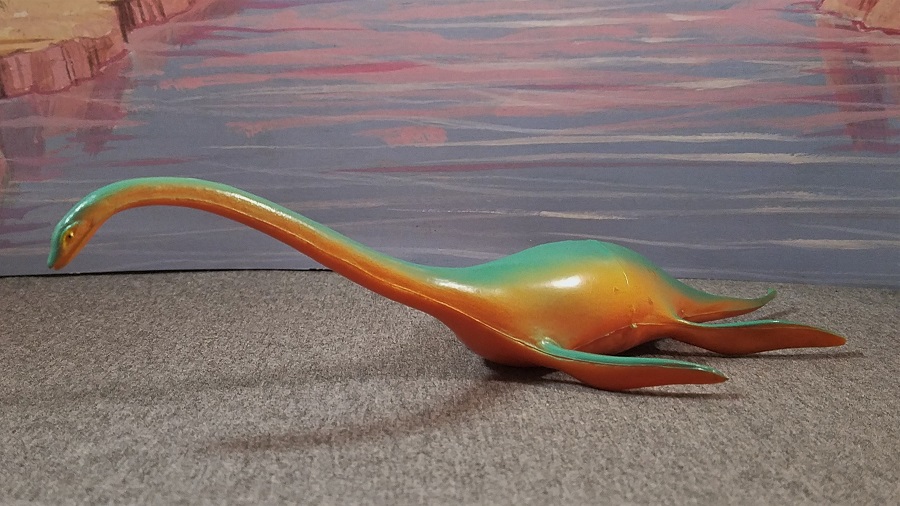
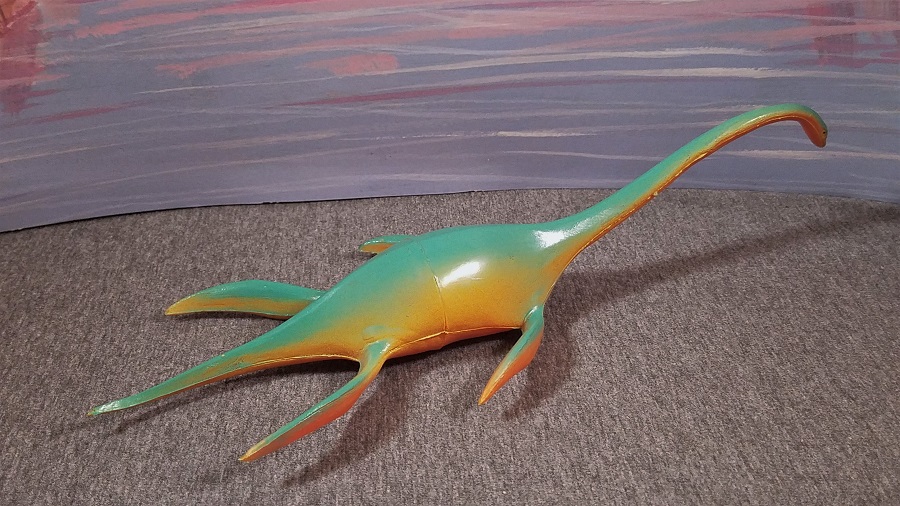
Perhaps the best trait of Larami’s (2nd version) Plesiosaurus is its color scheme. Larami released the Plesiosaur in more than one paint variant over the years, but the best version may be this one, which starts with a broad stripe of aquamarine along the back and neck, as well as the tops of the flippers. This gradually blends into golden-yellow on the figure’s flanks, before transitioning into a saturated orange for the entire underside (the eyeballs are also very neatly painted a beady black). It’s quite a pretty color scheme which complements the sculpt in conveying a serene aesthetic. One could easily picture a classical snapshot of the ancient marine reptile paddling across a lagoon in the evening time, awash in the soft glowing rays of a Mesozoic sunset. This is easily the most attractive and well-made figure in this Larami set, in my opinion – even if that’s mostly on the merit of the model Larami was copying, rather than this figure’s own.
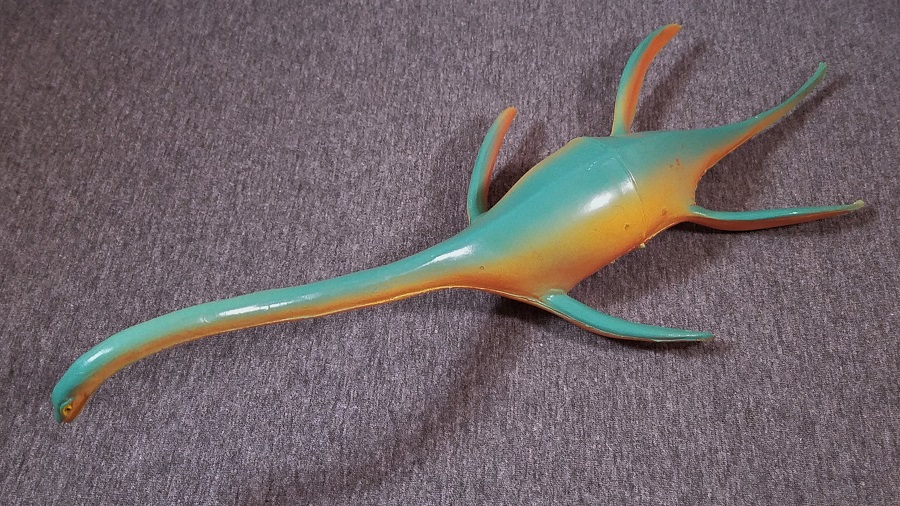
The third figure in the set, Triceratops, takes a few more liberties in its design from the Invicta design it’s derived from. Measuring just over 14 cm (5.5 in) long and around 5.5 cm (2.25 in) tall at the hip, the Larami “Tops” is once again hollow and squishy in make. The figure eschews Invicta’s overlapping armor plating along the back in favor of scattered, enlarged scales over a stippled skin texture (amusingly, Larami actually has the advantage of hindsight, as evidence now exists to support integument on Triceratops that’s more similar to Larami’s version than Invicta’s). The face has been tweaked, giving the figure a shorter, scrunched face with a humorously sour expression. The brow horns bulge a bit oddly and stick out straight like bayonets from the forehead. The frill is neatly round (with a cloverleaf edge), but rather small in proportion. The figure does retain Invicta’s rather awkward-looking posture with a low-slung shoulder girdle and sharply raised hip, almost plowing the figure’s face into the ground.
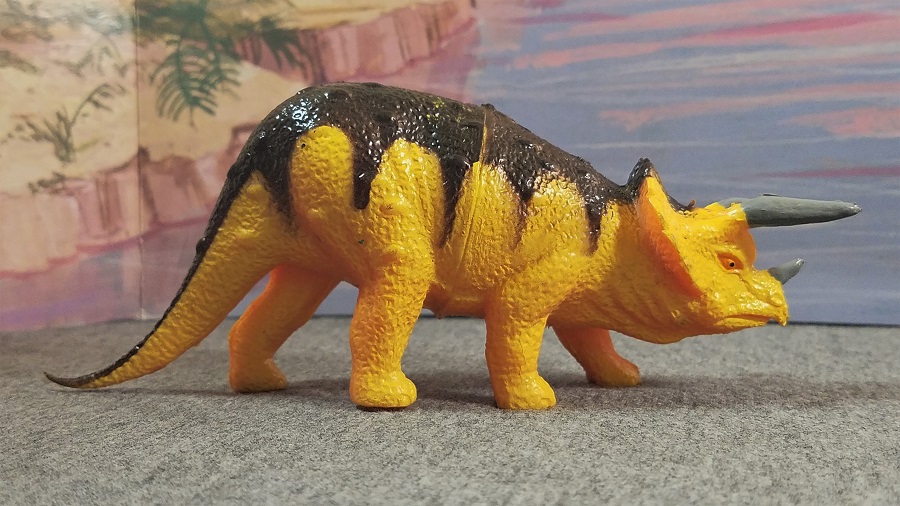
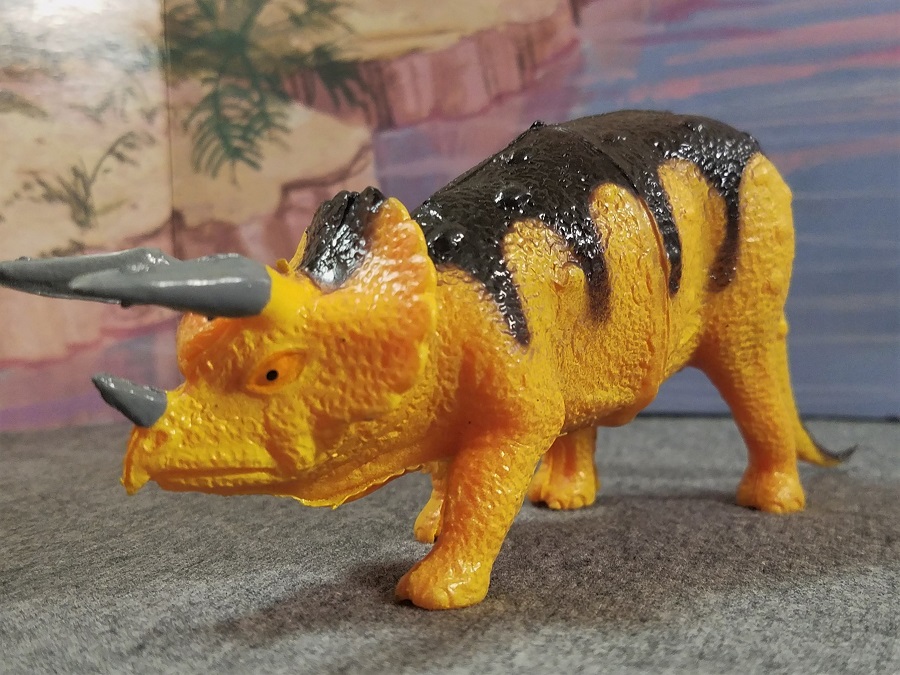
Coloration for Triceratops comes primarily in bright yellow, with blackish-brown along the back and spilling down the sides of the body. The underbelly is a similar orange to the Plesiosaurus, blending smoothly with the yellow flanks. The eyes are also orange with black pupils, and the horns are a flat, solid grey. It’s not as distinct of a scheme as in the prior two figures covered, but it’s striking all the same; and painting a large, angry horned herbivore with the equivalent of a wasp’s patterns seems apt somehow, amusingly. Larami’s Tops certainly doesn’t look like it’s going to put up with any nonsense! All in all, this isn’t as nicely designed as the Plesiosaurus, but it’s still an improvement over the Apatosaurus.
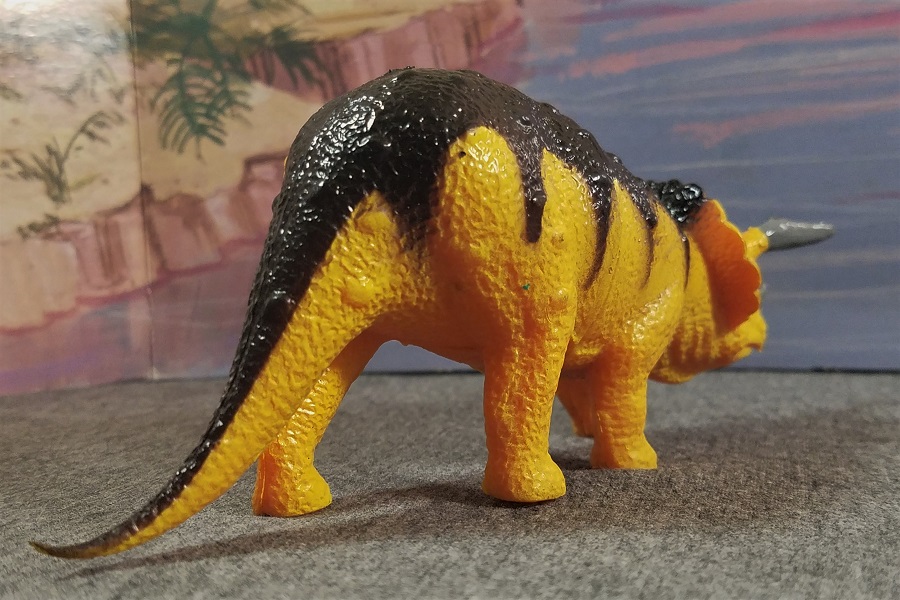
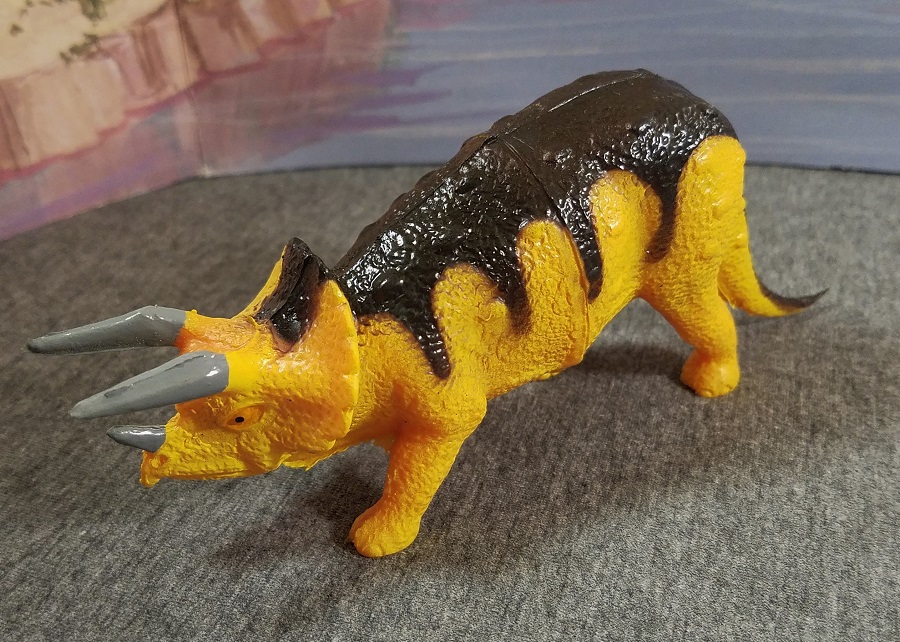
The fourth figure in the Larami set – complementary to Triceratops – is the ever-iconic Tyrannosaurus, once again derived from the counterpart in the Invicta Museum line. Larami’s Tyrannosaurus measures 25.5 cm (10 in) long and 11cm (4.25 in) tall at the head, tying with the Plesiosaurus for the second-largest figure in the set. Like the other figures in Larami’s set, the Tyrannosaurus is soft rubber; but instead of being hollow this figure is solid, perhaps due to the more slender body sculpt. The figure retains the long, striding pose of Invicta’s design, but trades out scales and scutes for a cruder, striated skin texture like that of the Apatosaurus covered previously. In this case, the Tyrannosaurus ends up almost looking like it has a shaggy coat of hair from certain angles. The soft rubbery plastic also works against this figure instead of in its favor; my rex has issues standing due to how easily the legs give way. This wasn’t an issue for Invicta’s hard plastics, but in soft rubber form the sculpt shows signs of imbalance. Facial features have also suffered a little, with a more emphasized narrow skull, enlarged eyes, and a rather silly-looking toothy grin. There’s no mistaking this toy as anything other than Tyrannosaurus, and it’s still a charming figure; but it definitely reads as a “plaything” more than it does “museum replica”.
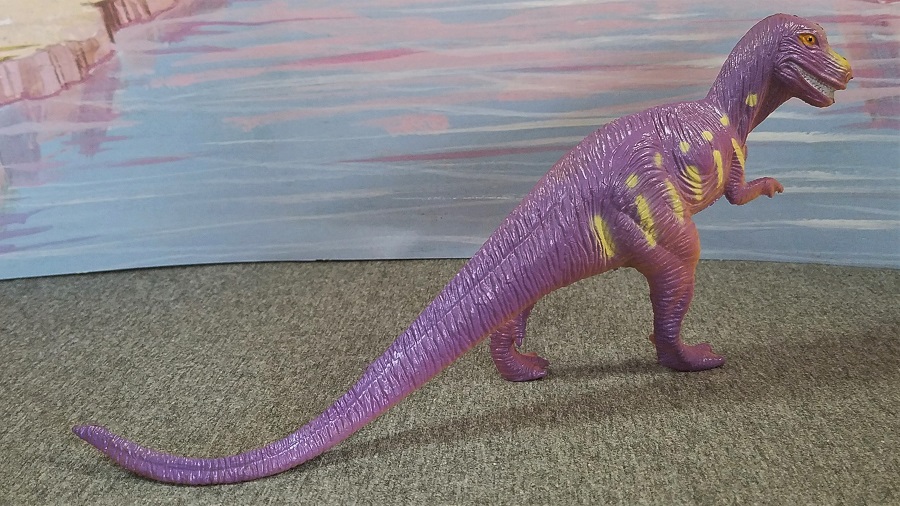
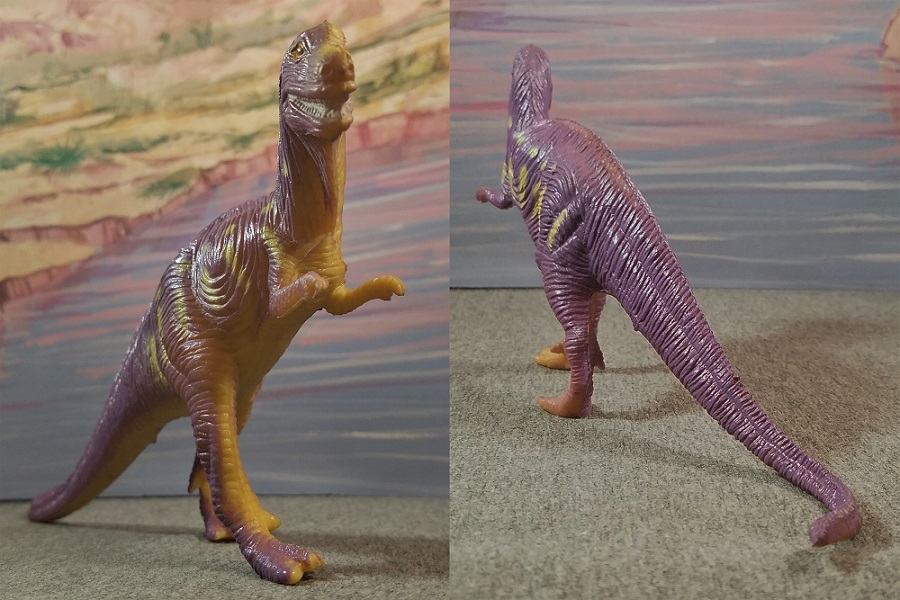
Like the other figures in the set, Tyrannosaurus received a new paint scheme for this 1990s reissue. Larami’s box art depicts the featured theropod in green & orange hues (reminiscent of the Imperial toy released around the same time frame); another variant, which was covered here on the Dinosaur Toy Blog once upon a time, was painted in dull, dark hues of bluish-green. The variant featured in this 90s reissue is easily the best version, in my opinion: this Tyrannosaurus comes painted predominantly in rich purple, with an underbelly painted in bright yellow that seeps upwards onto the face, flanks and limbs. The effect almost gives the figure a glowing appearance, similar to the gradient patterns on the Plesiosaurus. A few additional yellow stripes, like a row of dotted lowercase “I’s”, run across each side of the body; they’re crudely implemented, but help break up the silhouette and make the toy pop a little more in appearance. Out of the four figures reissued in this set, I’d say Tyrannosaurus was the one ended up benefitting from its repaint the most.
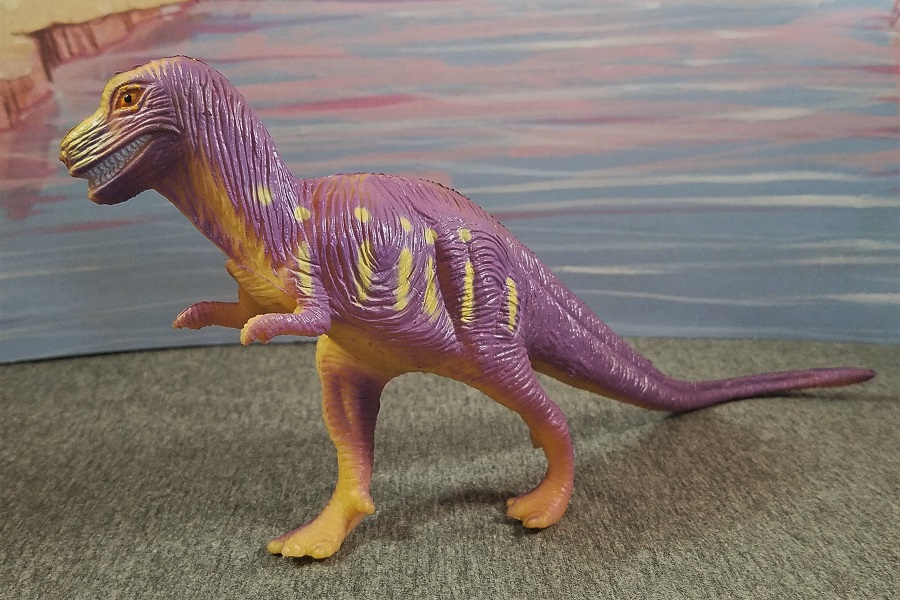
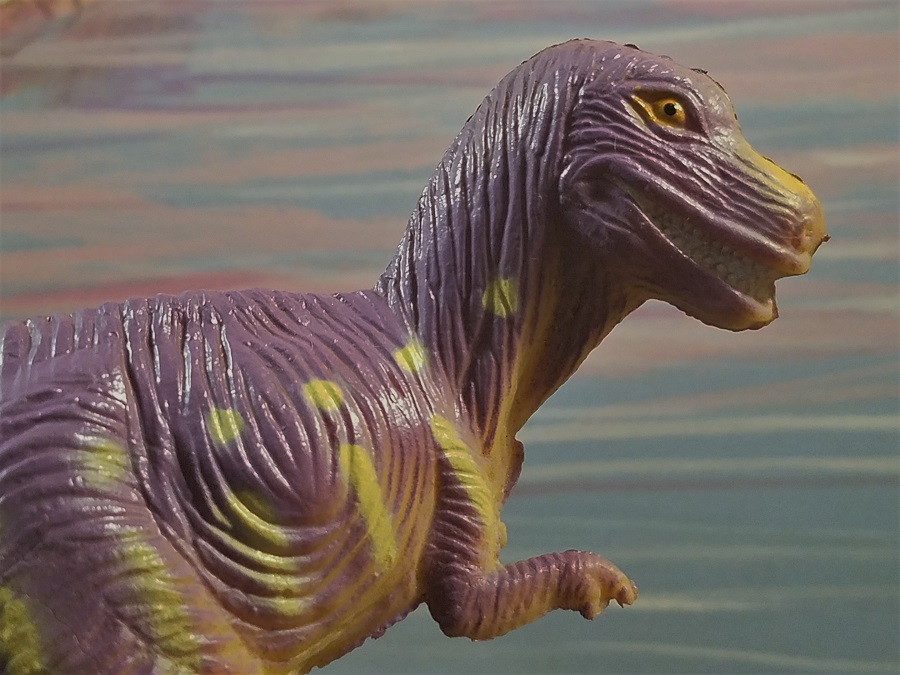
Larami’s “Museum Collection” Dinosaur sets are ultimately a charming relic of dinosaur toy history: an example of an age-old practice in commercialism which has sadly only gotten worse within the industry. To Larami’s credit, it really does feel like the company wanted to produce a higher-quality product with these sets, between the packaging and additional posters and backdrops; and even though most of these “new” toys were still copies of another, better brand, Larami tried to put their own spin on the designs and release something easily distinguishable from what Invicta was offering with their original line. This “Series 2” set of Dinosaurs hasn’t aged particularly well, but it’s an endearing product altogether and can make either a neat collector’s piece or a fun playset for the young ones – after all, that’s who these toys were originally made for, right?
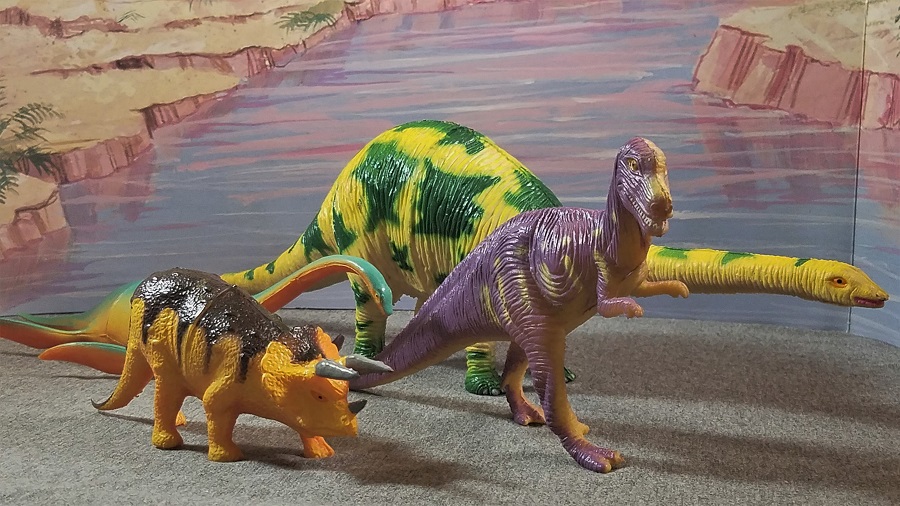
Granted, finding a complete Larami boxed set may prove difficult these days; most Larami figures will found loose, as individual figures or scattered amongst larger lots. You can check listings on eBay or other 2nd-hand sites like eCrater or Etsy. Who knows? Chances might work in your favor like they did with me.
Disclaimer: links to Ebay and Amazon on the DinoToyBlog are affiliate links, so we make a small commission if you use them. Thanks for supporting us!



I have been trying for YEARS to figure out the brand name of the dinosaur sets I had as a kid. I had all 3. I recognized this one from the bright apatosaurus and the purple tyrannosaur. I remember my brachiosaur was the soft squishy resin (I could fill it with bathtub water, turn it upside down, and spray it at people! I was a menace at 7.) and it was some dark color with orange striping, and the diplodocus was a beautiful grey and teal. I would love to own that particular diplodocus.
Excellent review. I had most of the Larami toys as a kid, although in this set it was series 1 that I had. It’s amazing I didn’t get lead poisoning from these things. Handle with care!
Had series 1 and 2 as kid however the series 2 was painted to look like the Carnegie Collection.
This is the 100th Triceratops review on the blog!
Sweet!
…My apologies it didn’t go to a more deserving toy, though; haha!
Ah, I remember the sets way back in the 90’s before I even started collecting, they were one of the few sets you see in stores like target.
I don’t think I have anymore of these figures in
my collection but I once had the plesiosaur and diplodocus.
This is so nostalgic, but also like I’m peeking into an alternate reality- I grew up with (and still own) the first release of all the Larami sets, with the duller colors. The Plesiosaurus and Tyrannosaurus are particularly nice with the updated paint jobs! Good point about the first release rex matching the old Imperial rex- it 100% does and I would always group them together while playing with them. Also love the backdrops these came with, they’re so lovely. Great review!
As a side note- the Ankylosaurus from another set was absolutely lethal and SHARP. Such a little gremlin, haha
Wow, is there anyway to just get the backdrops? Those would be great for my daily ‘Museum’ posts on ATF and DTF
I can’t say I’ve looked into it, but I wouldn’t be surprised if somebody out there is selling just the backdrop or other box pieces. My guess (and that’s all it is) is those are rarer than the dinos themselves, though.